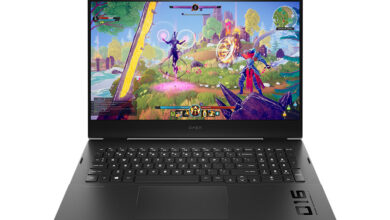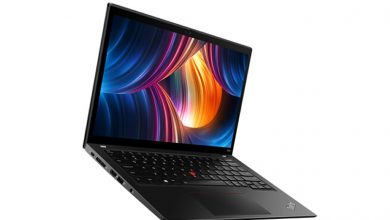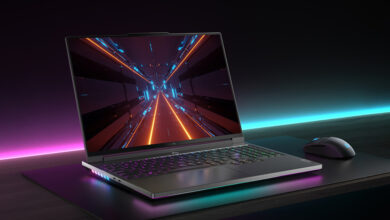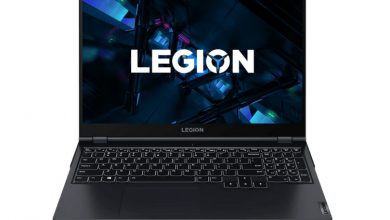At the Lenovo ThinkPad 2021 spring launch event in Beijing, tagged Hello Pioneer, the company unveiled three flagship products in the X1 series. Today, we finally have the Lenovo ThinkPad X1 Yoga Gen 6 for review. The ThinkPad series is Lenovo’s option for business users and students. Thus, the company does not equip this series with the best power supply, which has been a problem for many users.
However, Lenovo has listened to the voice of the market and equipped this new thin and light office notebook with a better power adapter. This is one of the first things you will notice with the ThinkPad X1 Yoga Gen 6 if you are a constant Lenovo user. This notebook comes with a standard small power adapter that weighs only 307 grams. Relative to the original 339g adapter, this new adapter not only reduces the weight by 30g, it also reduces the length and thickness of the adapter. Furthermore, this adapter supports the PD charging protocol and maintains a maximum power supply capacity of 65W. Since this device supports a USB Type-C port, it can meet the need for one charger for multiple devices.
Specifications
| Screen | 14″ FHD+ (1920 x 1200) IPS, anti-glare, touchscreen, 400 nits, TÜV Rheinland-certified for reduced blue light emissions, LP140WU1-SPB1 |
| Processor | Intel’s 11th gen Core i7-1165G7 10nm chip (2.8GHz 4 cores and 8 threads) |
| Wireless Connection | Intel AX201 WiFi 6 802.11 AX, Bluetooth 5.1 |
| Graphics card | Intel Iris Xe Graphics |
| Memory | 16 LPDDR4x 4266MHz |
| Storage | 512GB PCIe SSD |
| Camera | Hybrid infrared (IR) 720p HD with webcam privacy shutter |
| Ports |
|
| Battery | 57Whr (MM18) that supports a rapid charging USB-C 65W power adapter |
| OS | Windows 10 Home |
| Weight | 1.35kg |
Lenovo ThinkPad X1 Yoga Gen 6 Design and Appearance
On the appearance of this device, Lenovo made a significant improvement. The company used a full aluminum design for this laptop and a large part of the body is made of a frosted brushed finish on all sides of the body. This brushed finish gives the ThinkPad X1 Yoga Gen 6 a premium feel and a good grip. Furthermore, the designer also chamfered the corners of different surfaces and interfaces such that there is a good allowance to pick it up from any side.
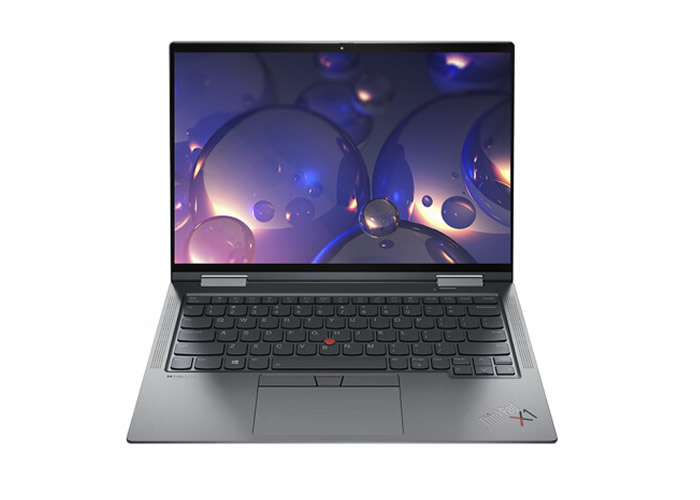
The general appearance of this device looks very sharp and angular, but when you touch it, it doesn’t feel like it cuts your hand. Of course, this is nothing but exquisite workmanship. Because the color of the brushed part of the body is the silver-gray of the aluminum material itself, when using this device, you don’t have to worry about paint loss. However, the paint job is top-notch, just as it has been with previous generations.
In addition, the color change of the ThinkPad logo is an eye-catcher. On one angle, you have the ThinkPad X1 engraving, while the opposite diagonal end has the Lenovo engraving. Other changes to the design include the repositioning of the vents and the new dual-fan cooling system which can be seen from the air inlet because the air inlet moves from the side to the rear.
With the new all-metal body design, users may be worried about two aspects – power leakage and weight. Answering questions regarding the power leakage, Lenovo claims that it did a proper such that there will be no power leakage. For our review, we used this laptop for hours while connected to a power supply, and there was no power leakage, not even a tingling feeling. However, Lenovo advises that we should use only chargers that meet national standards for this device. The company said, “If you are using a circuit that meets the national standards, put the three-pin power plug that meets the national standard into a national standard power outlet, and this ThinkPad X1 Yoga Gen 6 will not have any leakage feeling.”
This notebook weighs approximately 1.4 kg, and with the original power adapter, the travel weight is only 1.7kg. Of course, we can not say that this device is extremely light, but it also does not cause much trouble for the mobile office.
The Lenovo ThinkPad X1 Yoga Gen 6 can seamlessly switch from a laptop to a tablet, many thanks to its 360-degree hinge.
Lenovo ThinkPad X1 Yoga Gen 6 Display
If the changes in the design and appearance do not impress you, we are sure that the changes in the display will not disappoint. First off, you can see that the huge bottom bezel that users have complained about for many years is gone. This device comes with a 14″ 2-in-1 touchscreen laptop with a display ratio of 16:10 and an aspect ratio of 83%.
The ThinkPad X1 Yoga Gen 6 display bezels are not as narrow as they can be. There is certainly room for improvement, but it also avoids the problem of light leakage around the ultra-narrow bezel. The overall feel of this display is quite good, a solid improvement relative to the previous generation.
On top of the screen, there is an integrated IR camera with a ThinkShutter black valve and an HPD sensor. Although we can use the Glance program to achieve a similar function of the HPD auto lock screen through the IR camera, the HPD sensor additionally provides a contactless face recognition auto-login function. Since the relevant functions are controlled directly from the hardware layer, the HPD sensor can operate independently of any third-party software. Furthermore, all the parameters are managed directly in the BIOS. This makes it very energy efficient. Also, on the top of the screen are four array microphone openings. These microphones support hardware-integrated anti-noise thus there is no need to rely on software algorithms to achieve the anti-noise feature. As someone who needs to use a laptop for web conferencing on a regular basis, this is a feature that you absolutely need.
Why have a laptop with a touch-screen function and it does not support a stylus? Well, the Lenovo ThinkPad X1 Yoga Gen 6 supports a stylus (ThinkPad Pen Pro), and there is a provision for storing the stylus inside the body. This obviously prevents accidental loss of the stylus pen, and it puts this notebook a step ahead of the competition when it comes to the stylus design. Also, while the stylus is in its compartment, it is continuously charging. This means that you don’t even have to think about charging the stylus. Just slot it into its storage facility embedded in the laptop and its charging.
The stylus is thin, short, and small. However, it is a very active device with an electromagnetic response, and it supports the Wacom protocol. This device also supports 4096-level pressure sensing, so it is very responsive to touches while writing.
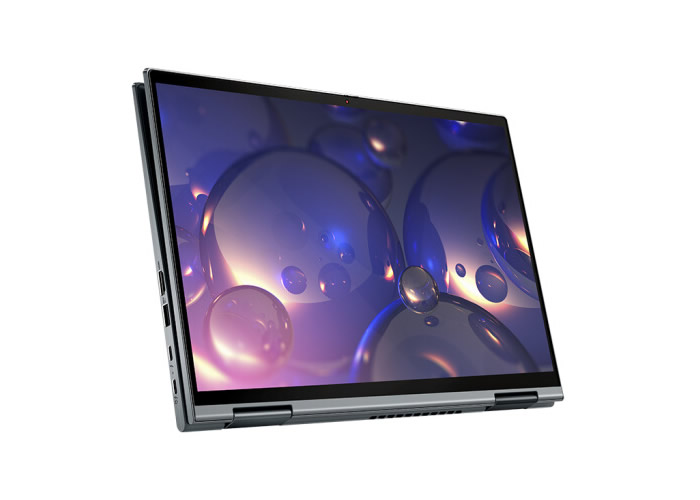
The ThinkPad X1 Yoga Gen 6 uses an LG display with model number LP140WU1-SPB1. It is a 14-inch custom display with a resolution of 1920 x 1200. This display supports NTSC-C color gamut, anti-harmful blue light, HDR video streaming, and a maximum brightness of 418nit in SDR mode. Furthermore, its contrast ratio is close to 1700:1. The screen’s native Gamma is 2.23, while the native color temperature is 6800K.
After color correction according to the sRGB color standard, the color gamut is 97.8% sRGB, 72% Adobe RGB, and 73% DCI-P3. When comparing with the sRGB standard, except for blue, DeltaE value, color temperature, gamma, and gray balance of other colors are perfect. When compared to the NTSC-C standard. all indicators are perfect. From these, we can safely say that the screen is very comfortable to use with Windows.
Lenovo ThinkPad X1 Yoga Gen 6 Keyboard
On the keyboard end, the first thing you will notice is that it has the same color as the body. The silver-gray polished ThinkPad logo gives the palm rest a qualitative leap forward. Compared to the complicated color scheme on the palmrest of the 5th-generation model, the texture of the palmrest of the sixth-generation model is a significant improvement in design.
Interestingly, the keycaps are also made of metal, but they are well-polished and offer a very smooth feel. Furthermore, Lenovo re-introduced the fingerprint sensor, which is integrated into the power button. Compared to the previous fingerprint reader that was placed under the keyboard, this design is much easier to access.
There is plenty of space for the fingerprint sensor on the right side of the device; however, the company chooses to place it with the power button. This means that in tablet mode, the user has to lift the screen up to be able to access the fingerprint sensor. Whether you are unlocking the device or need to do a biometric authentication, you will have to lift up the screen. This is not entirely thoughtful of Lenovo.
The FnLock, F1, and CapsLock keys on the keyboard have status lights. F1 and CapsLock’s status lights are in the upper right corner.
The status light of FnLock is placed on the right side in the center of the top and bottom. This is a bit weird as the status light of the FnLock button can be placed on the right side of the keycap like the other two buttons.
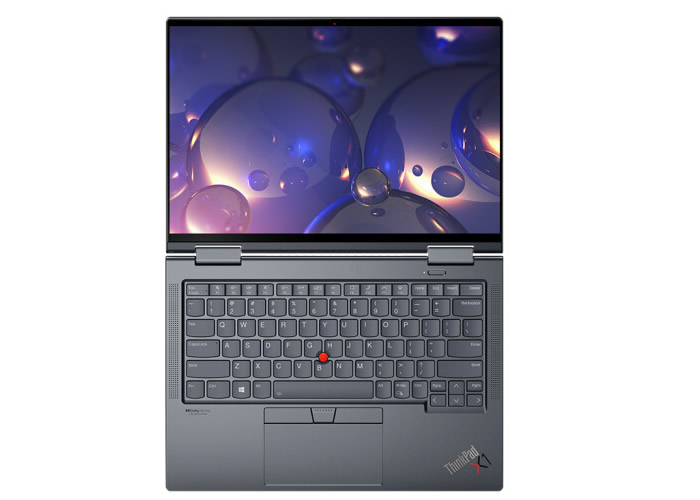
Furthermore, the keyboard is spill-resistant, which means that you don’t have to worry about having a coffee while writing. If you mistakingly spill the coffee on the keyboard, you have nothing to worry about. Furthermore, the keyboard has a wider 110mm / 4.33″ TrackPad. Lastly, the keyboard supports backlit with white LED lighting, a feature that every 2021 keyboard should have.
Lenovo ThinkPad X1 Yoga Gen 6 Ports
The Lenovo ThinkPad X1 Yoga Gen 6 has eight ports, and they are spread evenly on both sides. On the left side, this device has two Thunderbolt 4 ports with 40Gbps bandwidth, one USB 3.2 Gen 1 port with 5Gbps bandwidth, and one HDMI 2.0 port.
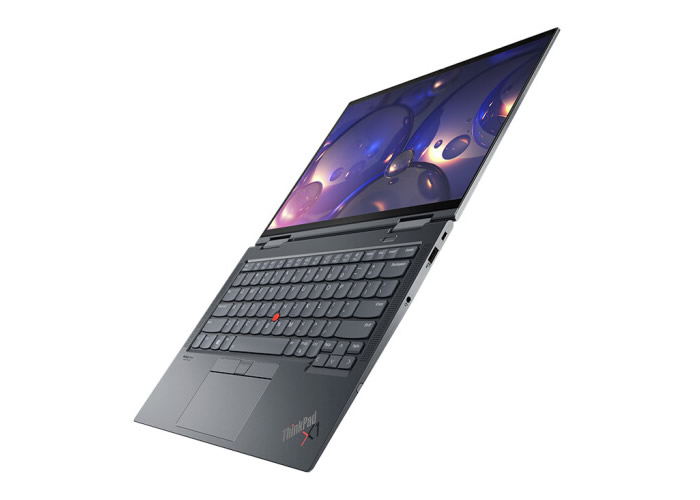
On the right side of the chassis, there is one anti-theft lock hole (Kensington lock slot), a 5Gbps USB 3.2 Gen 1 port with broadband shutdown charging, a 3.5mm headset jack, and the storage garage for the stylus (this is not a connectivity slot). The official recommendation is to use the Thunderbolt 4 port as close to the spindle as possible, as the charging port supports 45W and 65W PD charging protocol.
Hardware
To expose the hardware of this device, the back cover is pretty easy to open. All you need to do is simply unscrew 5 screws at the bottom, then carefully loosen the rear, left, and right-wing clips, and you’re done. After removing the bottom cover, you will see that the cooling system uses a new single thick heat pipe + dual-fan structure. The company used a special design for the fan blades (prime number of each other), which effectively reduced resonance and noise.
The CPU of this device is Intel’s 11th generation Core i7-1165G7 low voltage chip based on Tiger Lake core and built with a 10 nm process. This chip comes with 4 cores and 8 threads and has a base frequency of 2.8GHz. The full-core RWD gets up to 4.1GHz, while the single-core RWD gets up to 4.7GHz. The thermal design power consumption hits 28W, while PL1 and PL2 are both 64W. While PL1 is the effective long-term expected steady-state power consumption of the processor, PL2 is the short-term maximum power draw of the processor.
This CPU has integrated UP3 GT2 level Iris Xe core graphics with an operating frequency of 1.3GHz and it also has 96 execution units. Furthermore, the model we reviewed comes with 16GB LPDDR4x RAM with a maximum operating frequency of 4266MHz. It also has a 512GB SSD (PM9A1 from Samsung; PCI-E 4.0 protocol NVMe drive)
In addition, the NIC is an Intel AX201, and there is a free M.2 port that can be used to place the WWAN network card. Because this is not an LTE model, there is no network card and antenna.
The battery is from Xinwanda and has a capacity of 57Wh. There is a Rest button on the left side. If something goes wrong with the computer, you can use the thimble to poke the hole on the side of the device to reboot. In addition, there is also a low-mid frequency speaker on the bottom left and right and another mid-high frequency speaker on the left and right of the keyboard area. This leaves a total of four speakers on this laptop.
The speaker of ThinkPad X1 Yoga Gen 6 also comes with the Dolby Atoms certification. Although I used to say that ThinkPad’s audio is good enough for work, but not good enough for entertainment, the sound of this X1 Yoga is very good. However, the company made some improvements in the sound aspect. The overall soundstage has been widened while continuing to ensure that the vocals are prominent enough. The separation between high and low frequencies is also good. However, the strength of the low frequency is still a little weak. Due to harmonic distortion, the sound seems a little scattered. If you want to enjoy the sound output, we will recommend that you put on headphones.
Performance testing
Next, let’s look at the performance of the computer. Using the Cinebench R23 benchmark, in both laptop and stand mode, no matter what power mode is used, the core i7-1165G7 gets a score of 4900 for multi-core and 1450+ for single-core.
In the tablet mode, probably due to the cooling strategy, in the average performance power mode, it scored 4250 multi-core and 1370 single-core. However, in the “best performance” mode, this device runs close to the desktop mode results, which can be said to be very impressive.
On PCMark10 testing, in the tablet mode, the highest score is 5240 at (laptop – best performance) mode while the lowest score is 4955 at (tablet – average performance) mode. The overall score is still relatively stable.
Let’s take a look at the capabilities of the graphics card, In the Time Spy test, the highest score is 1774 while the lowest score is 1720. In the Fire Strike test, the highest score is 4865 while the lowest score is 4300.
In the Wide Life and Wild Life Extreme tests, the highest scores are 12,585 and 3590, respectively, while the lowest scores are 12,359 and 3497, respectively. On Night Raid, the highest score is 17839, while the lowest score is 14605.
The GPU is quite good. The ThinkPad X1 Yoga Gen 6 does not struggle when playing 4K 60 fps high bit rate H265 video, and the video decoding ability is quite strong.
Battery Life and Power Consumption
With performance comes power consumption. We are all interested in the power consumption and heat dissipation of laptops. Let’s take a look at what the ThinkPad X1 Yoga Gen 6 has to offer
At the AIDA64 test, in the “average performance” power mode, the desktop mode can emit up to 25W at 3.8GHz. However, the tablet mode will emit up to 13W at 2.97GHz. In the “best performance” power mode, the desktop mode can release 27W at 4.09GHz, while the tablet mode can release up to 22W at 3.68GHz.
Furthermore, during the stress test, the noise control capability of the new generation dual-fan cooling system is also evident. When the fan is running at full speed, the noise level in desktop mode does not exceed 45 dB, while in tablet mode, it is below 40 dB.
I turned on the WiFi and adjusted the screen brightness to 50%. I used the PCMARK8 office scenario for the battery life test.
The X1 Yoga’s performance in best performance mode was 3 hours and 28 minutes. In the average performance mode, the battery lasted for 5 hours and 05 minutes. However, in the popular power saver mode mode, the result was 8 hours and 22 minutes. It can meet the needs of a full day of office work.
CPU Temperature
Paying attention to the CPU temperature during the performance test reveals that the temperature is constantly fluctuating. This is because there was a sudden drop in frequency during the test. For this reason, I placed two kinds of thermal grease with very good thermal conductivity. The Shin-Etsu 7868 keeps the device stable in all modes, and the stress CPUs are stable at 25W and 4.09GHz when baked alone. With this configuration, the Cinebench R23 highest score on the multi-core test is 5412, while the single-core score is 1509. This is a little bit higher than the previous highest multi-core of 5356 points and a single-core score of 1501 points while using the original silicon grease. If it is possible, I recommend that you replace the silicone grease by yourself if you are good at it.
However, even after replacing the silicon grease, when running Cinebench R23, the CPU still appears to be down-clocked. After running for a period of time, the CPU will experience a sudden drop in frequency but will quickly return to the original level of computing in a very short period of time, and after a period of strong performance, it experiences another sudden drop in frequency. After a period of about 5 minutes, it picks up again.
This characteristic of this device could be due to the 11th generation Core CPUs being able to release the power consumption of a single core to the limit. When running R23, the total power consumption of the CPU can be released up to 35W. The performance is quite powerful, but the heat generation will also be very strong. Even if the other cores do not hit the temperature limit, at least one core will hit the limit thus the entire CPU will cool down directly by downconverting. Thus, ThinkPad engineers need to provide a solution for those who need to use this X1 Yoga Gen 6 for a long time with a high CPU load.
Conclusion
When it comes to thin and light notebooks, we do not expect the computing frequency and performance to be the best but it can at least hit an average value. The Lenovo ThinkPad X1 Yoga Gen 6 does this, and it’s just enough for business and academic work. This notebook is one of Lenovo’s best 2021 notebooks in the ThinkPad family in terms of design, material, workmanship, performance of CPU, core graphics, hard drive, and even battery life.



